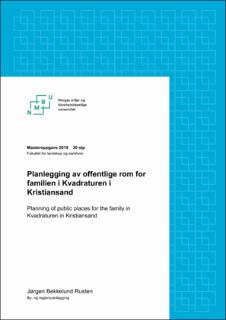| dc.contributor.advisor | Stefansdottir, Harpa | |
| dc.contributor.author | Rusten, Jørgen Bekkelund | |
| dc.coverage.spatial | Norway, Kristiansand | en_US |
| dc.date.accessioned | 2021-01-05T14:06:01Z | |
| dc.date.available | 2021-01-05T14:06:01Z | |
| dc.date.issued | 2019 | |
| dc.identifier.uri | https://hdl.handle.net/11250/2721550 | |
| dc.description | Med forord av Elin Børrud, koordinator for "Tverrfaglig masterklasse 2019" | en_US |
| dc.description.abstract | I denne oppgaven er det blitt undersøkt hvordan Kristiansand kommune planlegger offentlige rom i Kvadraturen med tanke på familien som brukergruppe. Videre er det også undersøkt i hvilken grad kommunen lykkes i å programmere og utforme offentlige rom for denne brukergruppen og dens ulike sammensetning av aldersgrupper.
Oppgaven er utført som en kvalitativ casestudie, med byrommet i Gyldenløves gate, og Aquaramaparken som utvalgte case. Gjennom litteraturstudie, redegjøres det for betydningen av sosial ekskludering og inviterende elementer i rommet, for å kunne planlegge gode offentlige rom for familien. Intervju og observasjon har videre bidratt med å belyse hvordan kommunen planlegger for å oppnå dette, og hvorvidt dette arbeidet har lykkes i caseområdene.
Undersøkelsene viser at Kristiansand kommune ikke har en bevisst målsetning for å inkludere og invitere familien når offentlige rom i Kvadraturen planlegges. Derimot er det et sterkt fokus på å inkludere og invitere barn og unge i programmering og utforming av byrom, og med en holdning om at dette også fører til gode rom for foreldre.
Byrommet i Gyldenløves gate inkluderer både yngre og eldre barn, ungdommer og foreldre. Lite tilrettelegging for barn fører imidlertid til at rommet i mindre grad inviterer familien. Aktivitetsområdet i Aquaramaparken har en inkluderende programmering for barn og unge, men i mindre grad for foreldre. Elementene i rommet er utformet for å aktivisere barn og unge gjennom ulike lekeapparater og et skateområde.
Fremtidig planlegging av offentlige rom i Kvadraturen bør derfor ta mer hensyn til de ulike aldersgruppene i familien. Dette kan kommunen gjøre ved å for eksempel ha mer fokus på familier hvor barn og foreldre har behov for forskjellige aktiviteter. | en_US |
| dc.description.abstract | This thesis has investigated how the municipality of Kristiansand plans public spaces in the city centre, Kvadraturen, with regards to the family as a user group. Furthermore, it has also investigated to what extent the municipality succeeds in programming and designing public spaces for this user group and its variety of age groups.
The thesis has been carried out as a qualitative case study, with the places in Gyldenløves gate, and the Aquarama Park as selected cases. Through literature, the importance of social exclusion and inviting elements in the space in order to be able to plan good public spaces for the family is explained. Interviews and observation have further helped to shed light on how the municipality plans to achieve this, and whether this work has been successful in the case places.
The study shows that the municipality Kristiansand does not have a conscious goal to include and invite the family when planning public places in the city centre. On the other hand, there is a strong focus on including and inviting children and young people in the programming and design of urban spaces, with the idea that this also leads to good spaces for parents.
The place in Gyldenløves gate is inclusive for both younger and older children, young people and parents. However, scarce facilitation for children means that the space is less inviting for the family. The activity area of the Aquarama Park has inclusive programming for children and young people, but to a lesser extent for parents. The elements of the space are designed to activate children and young people through various play equipment and a roller-skating area.
Future planning of public spaces in the Square should therefore pay more attention to the different age groups in the family. The municipality can do this by, for example, focusing more on families where children and parents need different activities. | en_US |
| dc.language.iso | nob | en_US |
| dc.publisher | Norwegian University of Life Sciences, Ås | en_US |
| dc.rights | Navngivelse 4.0 Internasjonal | * |
| dc.rights.uri | http://creativecommons.org/licenses/by/4.0/deed.no | * |
| dc.subject | Offentlige rom | en_US |
| dc.subject | Kristiansand | en_US |
| dc.subject | Familie | en_US |
| dc.subject | Planlegging | en_US |
| dc.title | Planlegging av offentlige rom for familien i Kvadraturen i Kristiansand | en_US |
| dc.title.alternative | Planning of public spaces for the family in Kvadraturen in Kristiansand | en_US |
| dc.type | Master thesis | en_US |
| dc.description.version | submittedVersion | en_US |
| dc.subject.nsi | VDP::Samfunnsvitenskap: 200::Urbanisme og fysisk planlegging: 230 | en_US |
| dc.source.pagenumber | 68 | en_US |
| dc.description.localcode | M-BYREG | en_US |

